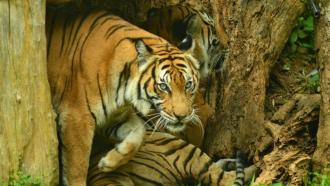Photo: Purabi Deshpande / Research Matters
Competition is everywhere in the natural world. Any attempt made to observe the natural system makes this evident. Carnivores compete with other carnivores over the best hunting grounds. Males compete for dominance over other males for reproductive advantage. Even something as simple as throwing a few grains of rice to a group of pigeons can demonstrate to us how inbuilt competition is in the natural world – a concept that has fascinated ecologist for many decades. These complex workings of ‘interspecific competition’ – competition between two different species of animals in natural systems -- has caught the attention of two undergraduate students from the Indian Institute of Science, Bangalore, and is the focus of their recent research.
One of the oldest and the most commonly used expression for studying competition between species is the Lotka-Volterra equation. The equation takes into account the total number of interacting species, the population sizes of each of the species, the carrying capacity of the species (the maximum number of individuals of the species that can be supported by its environment) and the intrinsic growth rate of the species (birth rate subtracted from the death rate).
Though there are so many variables, the equation doesn’t always do justice to the deep complexity of natural systems. Over the years, many researchers have modified the equation to take into account all parameters of the natural system in which the species are competing, in the process, making a lot of assumptions on the natural system that stray from reality. Some such assumptions include not considering the age and/or size of the competitors, all individuals consuming the same amount of resource, the resources never being consumed to extinction, not considering the interaction among resources and the growth rate of the consumers being dependent on the consumption of the resource.
The researchers of the study were quick to notice that some of these assumptions do not comply with a realistic system, and have focused on the competition coefficient – a term in Lotka-Volterra type equations that represent the effect one species has on another species. “We are trying here to find a new formulation for the competition coefficient, which is a major parameter in these equations. Usually it is put by hand or deduced mathematically from some resource growth models. We try here to deduce it from real field data”, says Mr. Anshuman Swain, one of the authors of the study.
The researchers have remodelled the competition coefficient using new terms that are relevant to field data. For example, consider a study that focuses on how jackals compete with tigers in the wild. Both the animals are carnivores and have a definite overlap in the prey they consume, resulting in competition for the resources. Jackals hunt in groups but a tiger searches for the prey alone. The modified formula allows the researchers of such study to take into account some of such behavioural characteristics of the study organism while calculating competition coefficients.
The modifications introduced by the researchers have far fetching effects. It overcomes the challenges posed by assumptions of previous models and fits natural systems better. It will also help other researchers to use the data they have collected in the field at specific time intervals to estimate population sizes – something that was not previously possible to great accuracy as growth was thought to be linear. The new model takes into account the fact that resources can be exhausted by a species, and the genetic background and age of the competitors can determine the minimum amount of the resource consumed by an individual. Finally, it also tackles the assumption that resources do not interact with one another.
“This model can be used to study most natural systems involving competition according to us, but hasn't yet been used to study any specific system. We have just given a new analytic formulation”, adds Mr. Swain. The model can not only be used to study inter-specific, but also different groups of the same animal, taking into account the effect of age. With the help of this improved formulation researchers can now, with a greater accuracy than before, estimate population sizes in their study system and understand to what extent two species are competing with each other






